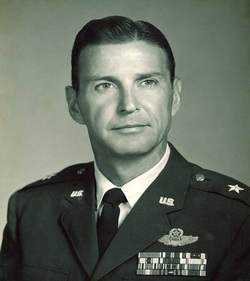He flew combat missions in the European theater during WWII and was shot down in July 1944 and spent the remainder of the war as a prisoner. After the war, he returned to Wright Field in Dayton, Ohio to resume experimental flight testing.
In 1946, while assigned to the Flight Test Division of Wright Field, he won the Thompson Trophy, flying one of the early F-80 Shooting Stars in the Cleveland Air Races. In 1948, he directed the XS-1 rocket powered research aircraft test program and served as one of it's three test pilots.
In his 29 years of military service with USAF, General Lundquist served as Chief of the Weapons Projects Section for the Atomic Energy Commission; Director of the USAF Engineering Liaison Office in London; Deputy Director of Air Weapons, Air Research and Development Command; Professor and Head of the Air Force Academy Physics Department; Deputy for Engineering and Technology at the Air Force systems Command Electronics Systems Division; Deputy Commander of the Rome Air Development Center, Griffiss Air Force Base, NY; Commander of the Systems Engineering Group, Wright Patterson Air Force Base, Ohio.
General Lundquist earned his B.S. degree from the University of Illinois and M.S. degree in nuclear physics from North Carolina State University and completed three years of his study of law. He was a registered professional engineer, a licensed commercial pilot and former Air Force command pilot, member of the Tennessee and National Society of Professional Engineers, former member of the Society of Experimental Test Pilots, and Associate Fellow of the American Institute of Aeronautics and Astronautics.
He was an Associate Administrator for Engineering and Development as well as executive director for all Federal Aviation Administration (FAA) research, engineering and development.
He was involved in major significant development projects including automation of air traffic control at primary facilities across the nation, new microwave guidance system for all weather approach and landings, aerosatellite applications with automatic communication and surveillance along with short haul aircraft and airport design and operational criteria. From 1970 through July 1976, he served as a member of NASA's research and technology advisory counsel.
He flew combat missions in the European theater during WWII and was shot down in July 1944 and spent the remainder of the war as a prisoner. After the war, he returned to Wright Field in Dayton, Ohio to resume experimental flight testing.
In 1946, while assigned to the Flight Test Division of Wright Field, he won the Thompson Trophy, flying one of the early F-80 Shooting Stars in the Cleveland Air Races. In 1948, he directed the XS-1 rocket powered research aircraft test program and served as one of it's three test pilots.
In his 29 years of military service with USAF, General Lundquist served as Chief of the Weapons Projects Section for the Atomic Energy Commission; Director of the USAF Engineering Liaison Office in London; Deputy Director of Air Weapons, Air Research and Development Command; Professor and Head of the Air Force Academy Physics Department; Deputy for Engineering and Technology at the Air Force systems Command Electronics Systems Division; Deputy Commander of the Rome Air Development Center, Griffiss Air Force Base, NY; Commander of the Systems Engineering Group, Wright Patterson Air Force Base, Ohio.
General Lundquist earned his B.S. degree from the University of Illinois and M.S. degree in nuclear physics from North Carolina State University and completed three years of his study of law. He was a registered professional engineer, a licensed commercial pilot and former Air Force command pilot, member of the Tennessee and National Society of Professional Engineers, former member of the Society of Experimental Test Pilots, and Associate Fellow of the American Institute of Aeronautics and Astronautics.
He was an Associate Administrator for Engineering and Development as well as executive director for all Federal Aviation Administration (FAA) research, engineering and development.
He was involved in major significant development projects including automation of air traffic control at primary facilities across the nation, new microwave guidance system for all weather approach and landings, aerosatellite applications with automatic communication and surveillance along with short haul aircraft and airport design and operational criteria. From 1970 through July 1976, he served as a member of NASA's research and technology advisory counsel.
Family Members
Sponsored by Ancestry
Advertisement
Advertisement


